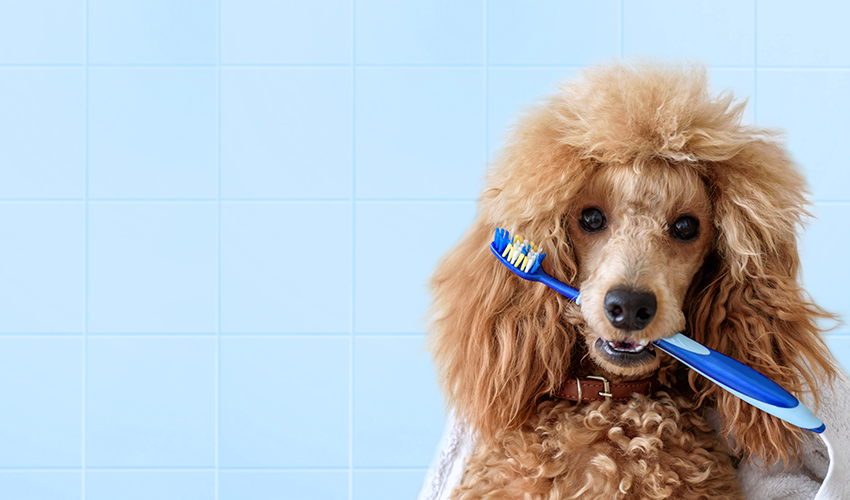It’s National Pet Dental Health Month, and veterinarians know that daily dental care for pets is far more than a cosmetic issue. Daily dental care is an important defense against periodontal disease, the most common cause of bad breath in dogs and cats.
Caused by plaque and tartar buildup, periodontal disease can cause tooth loss and oral lesions. Periodontal disease can also have a secondary effect on certain body organs (such as the heart, kidneys, and liver) and cause or exacerbate organ system diseases.
According to the American Veterinary Dental Society, more than 80% of dogs and 70% of cats have some form of dental disease by age three.
To help pet owners with pet dental care questions and help pets avoid the risks of periodontal disease, here’s a quick overview to print or email to clients, or post to your social channel:
Are dental problems the same for people and pets?
No. For people, tooth decay (or cavities) is the most common dental problem. Tooth decay represents less than 10% of all dental problems for dogs. The majority of dental problems for dogs and cats are caused by periodontal disease.
What causes plaque and tartar to form and how does this cause periodontal disease?
Similar to your mouth, your pet’s mouth is home to thousands of bacteria. As bacteria multiply on the surfaces of teeth, they form an invisible layer called plaque (or biofilm). While some plaque gets removed by your pet’s tongue and chewing habits, some remains.
If allowed to remain and build over time, plaque thickens and mineralizes to become tartar. This tartar accumulates both above and below the gum line, leading to inflammation (gingivitis) and further accumulation of plaque, which can lead to periodontal disease.
How can I help prevent plaque and tartar buildup?
Certain types of chew toys and treats may help reduce or delay plaque and tartar buildup, and some pet foods have been specifically formulated as dental diets that mechanically and/or chemically assist in plaque control. (Bones, antlers, and other hard chew toys are not recommended as they can cause fractures and chips to teeth.) Water additives are also available. Yet daily tooth brushing is the best defense against tartar buildup.
Can I use a toothpaste formulated for humans?
Absolutely not. You should never use human toothpaste to clean your pet’s teeth. Toothpaste contains ingredients that can cause intestinal problems for pets if swallowed, and some toothpaste contains xylitol.
As a sugar substitute, xylitol is safe for human consumption. Yet for dogs, xylitol can be lethal. Xylitol is rapidly absorbed into a pet’s bloodstream and can cause hypoglycemia (low blood sugar), liver failure, seizures, and even death in dogs.
You should also avoid using baking soda to clean your pet’s teeth. Baking soda has a high alkaline content, which can upset the acid balance in your pet’s digestive tract if swallowed.
To safely clean your pet’s teeth, specially formulated pet toothpastes are available. Pet toothpastes are non-foaming, safe to swallow, and are available in pet-appealing flavors, including poultry and beef, which help train your pet to look forward to daily dental care.
Will tooth brushing remove tartar that has already built up?
Once tartar has formed, you will need to take your pet to your veterinarian for professional scaling and polishing, done under a general anesthesia.
Do I have to make an appointment for my pet to have a dental scaling and polishing?
Yes. Your veterinarian will examine your pet for underlying or related disorders and perform preanesthetic bloodwork prior to the procedure.
What happens during a professional dental cleaning for my pet?
A dental-cleaning to remove tartar and periodontal disease-causing plaque always includes a thorough dental examination. Sometimes dental x-rays are recommended. These are especially important if tooth root problems are suspected. Everything is done while your pet is under general anesthesia.
In the case of advanced periodontal disease, with tooth root exposure, extractions may be needed and done during the procedure.
Since it is impossible for veterinarians to predict the extent of dental disease in advance of a thorough tooth and gum examination while under anaesthesia, your veterinarian may contact you during the dental cleaning to discuss any additional treatment that may be necessary.






